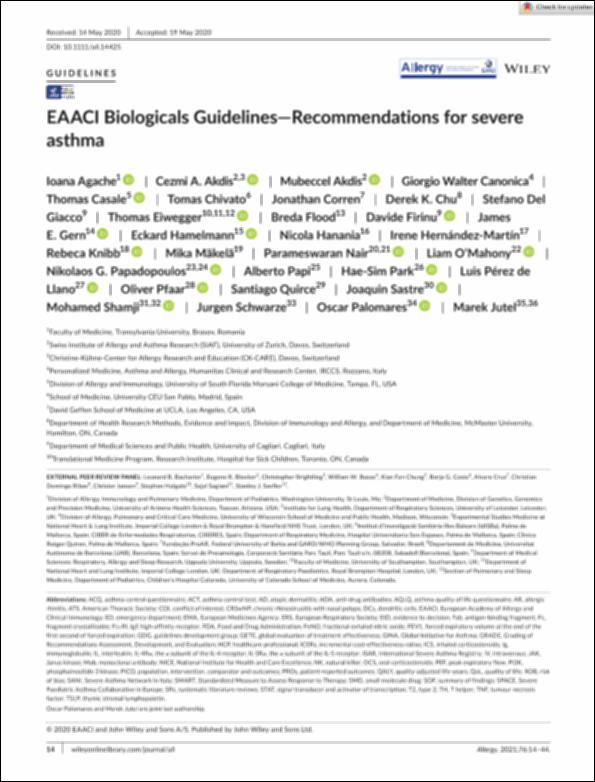Please use this identifier to cite or link to this item:
http://hdl.handle.net/10637/15126EAACI Biologicals Guidelines-Recommendations for severe asthma
| Title: | EAACI Biologicals Guidelines-Recommendations for severe asthma |
| Authors : | Agache, Ioana Akdis, Cezmi A. Akdis, Mubeccel Canonica, Giorgio Walter Casale, Thomas Chivato Pérez, Tomás Corren, Jonathan Chu, D. K. Giacco, Stefano del Eiwegger, Thomas Flood, B. Firinu, Davide Gern, James E. Hamelmann, Eckard Hanania, Nicola Hernández Martín, Irene Knibb, R. Mäkelä, Mika Nair, P. O'Mahony, Liam Papadopoulos, Nikolaos G. Papi, Alberto Park, Hae-Sim Pérez de Llano, Luis Pfaar, Oliver Quirce, Santiago Sastre, Joaquín Shamji, Mohamed Schwarze, Jürgen Palomares, Oscar Jutel, Marek |
| Keywords: | Biologicals; Cost-effectiveness; GRADE; Guidelines; Severe asthma |
| Publisher: | Wiley |
| Citation: | Agache I, Akdis C, Akdis M, et al. EAACI Biologicals Guidelines—Recommendations for severe asthma. Allergy. 2021;76:14–44. https://doi.org/10.1111/all.14425 |
| Abstract: | Severe asthma imposes a significant burden on patients, families and healthcare systems. Management is difficult, due to disease heterogeneity, co-morbidities, complexity in care pathways and differences between national or regional healthcare systems. Better understanding of the mechanisms has enabled a stratified approach to the management of severe asthma, supporting the use of targeted treatments with biologicals. However, there are still many issues that require further clarification. These include selection of a certain biological (as they all target overlapping disease phenotypes), the definition of response, strategies to enhance the responder rate, the duration of treatment and its regimen (in the clinic or home-based) and its costeffectiveness. The EAACI Guidelines on the use of biologicals in severe asthma follow the GRADE approach in formulating recommendations for each biological and each outcome. In addition, a management algorithm for the use of biologicals in the clinic is proposed, together with future approaches and research priorities. |
| URI: | http://hdl.handle.net/10637/15126 |
| Rights : | http://creativecommons.org/licenses/by-nc-nd/4.0/deed.es |
| ISSN: | 1398-9995 |
| Issue Date: | 2020 |
| Center : | Universidad San Pablo-CEU |
| Appears in Collections: | Medicina |
Items in DSpace are protected by copyright, with all rights reserved, unless otherwise indicated.


